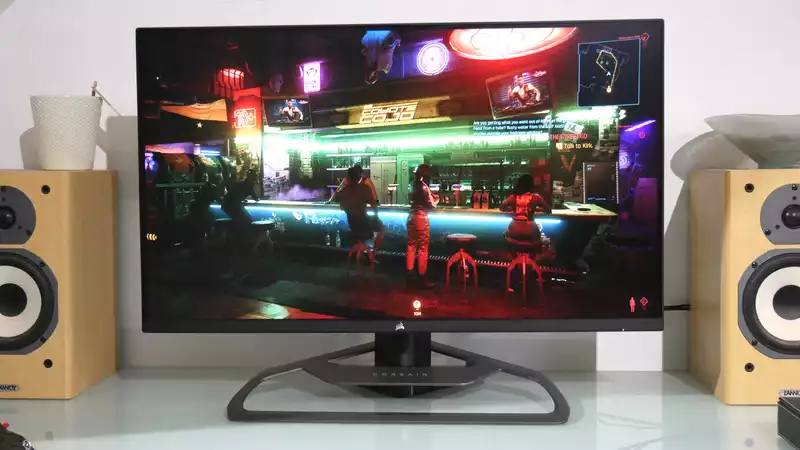Do you want an excellent all-rounder? Or one that is more specialized and has some amazing elements, but also some shortcomings and missing features" The new Corsair Xeneon 32QHD165 falls firmly into the first category. On paper, it's nothing special: 32", IPS panel, 165Hz refresh, 1440p resolution, sub-3ms responsiveness, basic HDR capabilities, you get the idea.
It's a great combination of features, of course, because 4K puts an unusual load on the GPU, and ultrawide monitors have their own limitations. At least, one might say that if it weren't for one small drawback. Price. The price is $799 (£699). That's a heck of a lot of money for a regular 1440p panel. It really is.
So how does the Corsair Xeneon 32QHD165 justify this price tag? The cast aluminum stand (adjustable for height, tilt, and swivel) is clearly superior to the standard in build quality; the attention to detail in the OSD menus is also more clear and logical than usual; and the display is more than adequate for the price. In short, there is an unusually high level of refinement everywhere one looks.
The detailed specs are mostly good news, but equally debatable as to whether there is enough to make up for the price tag: the native resolution of 2,560 x 1,440 pixels combined with the ratio of the 32" 16:9 aspect panel results in a 100 DPI or less pixel density. This is not necessarily a major issue within games. But in broader computing, the pixels will be coarse. Then again, at this price point, a screen with all-around accuracy as well as pure gaming feel may be required.
On the speed side, 165 Hz refresh is complemented by 1 ms MPRT and sub-3 ms gray-to-gray pixel response. Decent numbers, to be sure. But the fastest 1440p IPS panels now record 240Hz and 1ms gray-to-gray. In other words, there is no disputing that your money is being spent there.
The same goes for HDR performance: the Corsair Xeneon 32QHD165 is VESA DisplayHDR 400 certified, with a peak brightness of 400 nits. Inevitably, there is no local dimming, and this is not a true HDR display. Static contrast, on the other hand, is 1,000:1, which is normal for an IPS panel.
One area where it is slightly better than standard is color accuracy; Corsair claims 98% coverage of the DCI-P3 color space, which is closer to a professional content production panel than a gaming monitor, perhaps reflecting the use of quantum dot technology used in Xeneon's backlighting.
Another arguable advantage to the masses relates to inputs: two HDMI 2.0 sockets and a DisplayPort 1.4 interface are predictable enough. However, USB Type-C with power delivery, which allows a single cable to connect to a laptop while charging, is a welcome addition. At least, if the charging output is not limited to a mere 15W, it is barely enough for something like a MacBook Air, let alone a gaming laptop.
It is also worth noting that the HDMI port is limited to 144Hz; the Xeneon has a special "console mode" that accepts 4K input and downscales it to 1440p. This is obviously designed for the Sony PS5, which does not support 1440p. However, the basic idea of forcing a heavy 4K rendering load on the console just to downscale to 1440p makes little sense.
In any case, it is difficult to see speeds and feeds that would really explain the Corsair Xeneon 32QHD165's hefty price. So what about the actual viewing and gaming experience? "The core picture quality is certainly good. It is punchy, vibrant, and well tuned. Speeds are fast and seem very good for the claimed specs. However, the fastest of the available pixel overdrive modes shows just a little overshoot. It is also not as sharp and blur-free as the fastest 1ms GtG panels available today.
Overall, the monitor does a great job with games of all genres; shooters like Apex Legends are fast enough, with no discernible lag; graphics heavy games like CyberPunk 2077 Single-player adventures look decent at 1440p, even if they obviously don't get the insane detail of 4K, and the same goes for playing Total War-style strategy titles: at 1440p, the various in-game menus and panels, 1440p is sufficient to prevent the various in-game menus and panels from eating up too much of the available screen real estate.
On the other hand, the Corsair Xeneon 32QHD165 doesn't really excel at anything; Esports addicts will want something even faster. And gamers with deep pockets who want a truly dramatic visual experience will prefer either the 4K panel and the crazy detail and precision it brings, or the ultrawide option for the ultimate immersive experience.
Had the Corsair Xeneon 32QHD165 been a bit cheaper, it would have been easier to accept the fact that it was a credible all-rounder rather than an outstanding performer in any area. The same goes for the fact that the pixel pitch is too fat for general computing; at $800, it's a bit hard to swallow, and the LG UltraGear 32GP850-B, even if it can't match the overall quality and vividness of the Corsair's image quality, has the same panel size and resolution and offers slightly higher refresh and better response at a much cheaper price, it stands out in particular.
In short, the Corsair Xeneon 32QHD165 is a very good all-around gaming monitor. It is sleek, well executed, and an excellent all-rounder. However, for it to be truly attractive, the price is unfortunately about 30% higher than it should be.
.

Comments